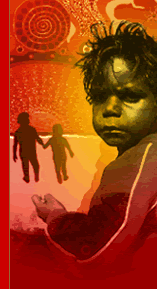

|
|
||
Briefing PaperThe Way Forward – A Ten Point National Action Plan to Prevent Child Abuse and Neglect11 July 2007 The way forward from here
is for the Federal Government to lead the development of a National
Action Plan to prevent and respond to child abuse and neglect within
all Aboriginal and Torres Strait Islander communities with the support
and involvement of states and territories, SNAICC and other representative
Indigenous organisations. SNAICC’s Ten Point National Action Plan1. Safety is paramount - responsive child protection. Allegations of child abuse and neglect must be investigated in a child centred way. Ensure child protection systems are well resourced to respond when called upon to properly investigate and intervene where children are at risk of abuse or neglect.
3. Effective policing - speak up against violence and abuse. Ensure the appropriate levels and forms of policing within communities are in place to enable people to speak out against violence and abuse without placing their own safety at risk. 4. Early intervention. Improve access to Indigenous community based early childhood, childcare, family support and child welfare programs to support families to access help early and promote children’s well being. 5. Connections to culture. Maintain children’s rights to be connected with their extended family and community and their cultural and spiritual heritage – child removal is a last resort. 6. Build on strengths. All Aboriginal families and communities have strengths and capacity to support and nurture their children. Governments must do things with local communities not to local communities. Recognise and build on the strengths of Aboriginal and Torres Strait Islander families, communities and kinship systems and develop workforce and community capacity. 7. Healing and restoration. Victims and perpetrators need access to a range of healing and therapeutic programs including alcohol and substance abuse rehabilitation, counselling and healing programs and family restoration programs to rebuild family relationships across generations. 8. Safe and Healthy communities. Disempowered communities with woeful housing, extreme poverty, chronic alcohol and substance abuse, few early childhood programs or health services, no economic base and inadequate schools are likely to have high rates of abuse and neglect. Well planned large scale investment over generations is required to create safe and healthy communities for all Australian children. 9. Listen to and do what works. Evidence on effective child protection systems from Australia and overseas demonstrates that community based and managed child protection systems achieve the best results. Governments should act on the best evidence and advice available – children deserve nothing less than a thorough response. 10. A national response for a national emergency. The Prime Minister has called child abuse in Aboriginal communities a national emergency – but the government has only developed a short term response for the NT. The problem requires sustained national commitment from all states, territories the commonwealth and non-government agencies planned and monitored through a National Indigenous Children’s Well Being and Development Taskforce.
SNAICC has written to Minister Brough and requested:
More Information:SNAICC
Keep up to dateYou can find out more about SNAICC's responses to the federal government's intervention on child abuse in NT. In the information on SNAICC's NT Response Update page is regularly updated. What else SNAICC is doing on this issue
First published 11 July 2007 < Back to SNAICC's NT Response UPDATE page
|
||
